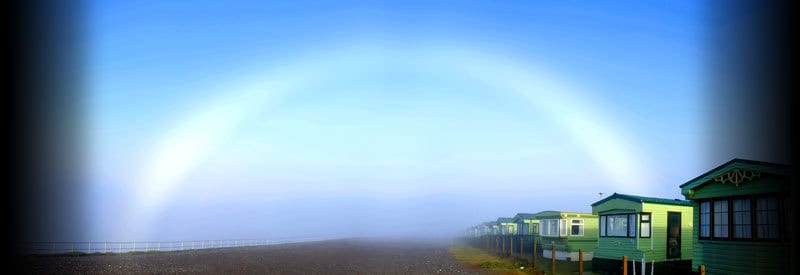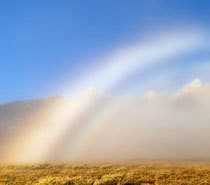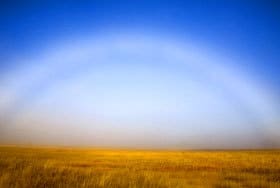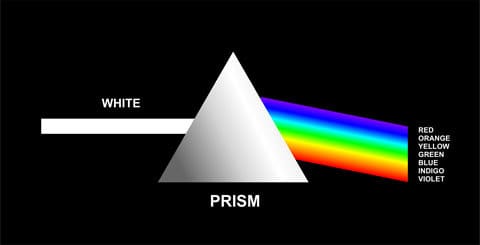The Fogbow: Rainbow’s Less Glamorous Cousin

If you ever observed this phenomenon, you could easily mistake it for a strange colorless rainbow. You may not be entirely incorrect, but a fogbow occurs through a slightly different meteorological process.
A fogbow is primarily defined as a white semicircular bow that appears in the presence of fog when water droplets reflect sunlight from within the fog bank. Unlike the luminous spectral colors of a rainbow, a fogbow appears primarily white due to the way microdroplets in fog reflect the sunlight.
Although they are both the result of the same meteorological process, a fogbow appears during foggy/misty conditions while a rainbow occurs in the presence of a rain shower (as the names suggest).
It may not seem like much of a difference, but the characteristics of fog result in a ghostly white phenomenon not too dissimilar from a rainbow stripped of all its color.
This article examines what a fogbow is, looks at its characteristics, as well as how it occurs.
What Is A Fogbow?
As the introduction already eluded to, in the simplest terms, a fogbow appears as a completely desaturated rainbow with its predominantly white appearance.
Before delving deeper into why and how it occurs, one first needs a clear and precise definition of what a fogbow is.
Fogbow Definition

A fogbow is a predominantly white semicircular bow that appears in the presence of fog when water droplets reflect sunlight from within the fog bank. Unlike the luminous spectral colors of a rainbow, a fogbow appears primarily white due to the way microdroplets in fog reflect the sunlight.
This summary provides a concise explanation of a fogbow, but to better understand why it occurs and how it differs from its more glamorous cousin, the rainbow, a broader clarification is needed.
Although the name "fogbow" is the most commonly known and widely used name for this phenomenon, a few other terms are also synonymous with this occurrence:
- White Rainbow (Aptly named after its predominantly white appearance.)
- Circle Of Ulloa (Named after General Antonio de Ulloa, who first draw attention to the phenomenon in the 18th century.)
- Ulloa's Ring (Another variation of the name used in the previous point.)
- Ghost Rainbow (Named after the ghostly white appearance of a fogbow.)
A fogbow is a relatively rare sight compared to rainbows and does not occur that often. What makes them even harder to spot, is the fact that they can appear almost indistinguishable from the surrounding fog with only a hint of contrast that makes visible.

Since a fogbow appears at the antisolar point, the sun needs to be approximately 20 degrees or less above the horizon for it to be visible as a semicircular ring. Any higher and the phenomenon will theoretically fall below the horizon and disappear from view.
(An antisolar point is a position on the celestial sphere situated directly opposite the sun from the observer's point of view.)
The semicircular ring visible above the horizon is only part of a full circle, which can be viewed in its totality if the observer is situated at an elevated position like a mountaintop.
Fogbows are almost as big as rainbows, but the ring (or bow) is much broader in size due to the amount of diffusion and light scattering by the small size of the droplets present in fog.
The following section will detail the process through which a fogbow occurs.
How A Fogbow Occurs
Like a rainbow, a fogbow is observed with your back towards the sun while looking directly into a bank of fog in front of you.
- The microdroplets in fog diffract (bend) and break up the sunlight into its constituent spectral colors, which results in the familiar color pattern that is so unique to a rainbow.
- However, as the microdroplets in fog are a fraction of the size of raindrops (up to a hundred times smaller), they react and scatter sunlight differently than rainbows.
- 3The size of the droplets results in the formation of multiple smaller beams of spectral light reflected and scattered in all directions. Many of these smaller beams of light come together, overlap, or merge to display a combined color of white.
- 4This process explains why a fogbow appears as a predominantly white ghostly semicircle. (Sometimes displaying spectral colors on the extreme side of the spectrum with a shade of red on its outer edge and blue on its inner edge.)
Fogbows Are All About Diffraction
The formation of a fogbow is also impossible to take place without the occurrence of a process known as diffraction.

As white light passes through a raindrop (as illustrated by the prism), refraction causes it to be broken up into its constituent spectral colors.
Diffraction is defined as the bending of light as it travels around or through an object. The diffraction of light as it passes through a raindrop is responsible for the breaking up of light into its spectral colors. We view these diffracted colors whenever observing a rainbow or fogbow.
The larger waterdrops in the rain act as a prism and break up (diffract) the sunlight into its constituent spectral colors, which are clearly visible in the resulting luminous rainbow.
Unlike rain, however, the smaller-sized droplets in fog cause less diffraction (bending) of light, which means a smaller separation into constituent spectral colors.
This means the light viewed by the observer is seen as primarily white (the combination of all spectral colors).
The conditions and specific characteristics of any fogbow may vary from one occurrence to another. However, the process described here, as well as the requirements that need to be in place for the phenomenon to occur, always remains the same.
Conclusion
As this post clearly highlighted, the process that is responsible for the formation of a rainbow is identical to the one that creates a fogbow. The only real difference is the size of the droplets in a fog bank.
The size of these micro-droplets, though, completely changes the characteristics of a fogbow, displaying a semicircular ring stripped of all its color. It is unique and eyecatching in its own right and can produce a spectacular display under the right conditions.
This article explained what a fogbow is, described its characteristics, and went on to explain its formation in detail.
Never miss out again when another interesting and helpful article is released and stay updated, while also receiving helpful tips & information by simply following this link .
Until next time, keep your eye on the weather!

